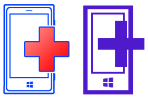The Nokia 3310 is a discontinued GSM mobile phone announced on 1 September 2000, and released in the fourth quarter of the year, replacing the popular Nokia 3210. It sold very well, being one of the most successful phones, with 126 million units sold worldwide, and being one of Nokia's most iconic devices. The phone is still widely acclaimed and has gained a cult status due to its reputation for durability.

A clamshell design is a kind of form factor for electronic devices in the shape of a clamshell. Mobile phones, handheld game consoles, and especially laptops, are often designed like clamshells. Clamshell devices are usually made of two sections connected by a hinge, each section containing either a flat panel display or an alphanumeric keyboard/keypad, which can fold into contact together like a bivalve shell.
Mobile music is music which can be transported, or in other words, mobile. The term itself is a bit ambiguous.

Microsoft Software Updater is a Windows and OS X based application launched in 2006, that enables customers to update and recover their mobile device firmware of a S40 or S60 or Lumia device from any Internet enabled access point. To avoid data loss users are prompted with on-screen advice on how to safely update their device.

The Nokia 6300 is a mobile telephone handset produced by Nokia. It was announced on 28 November 2006 and released in January 2007. This model was assembled in several factories, including Jucu plant, near Cluj, in Romania.

The Nokia 6280 Series, is a series of slider type phones first released in Q4, 2005.
The form factor of a mobile phone is its size, shape, and style, as well as the layout and position of its major components.
Nokia's strategic nomenclature can be traced back in 2005 when the Nseries line was launched, offering devices with flagship specifications and premium hardware at various price points. These devices were considered the "bread and butter" of the company and were often positioned to showcase their latest technologies. Thanks to the newfound consumer and enterprise interest in smartphones at the time, the company introduced four additional collections to diversify their product portfolio and meet demands in most market segments. These new phone series were named Eseries, targeting small business and enterprise customers; Xseries, providing consumer-grade multimedia-focused devices; Cseries, which Nokia used to target both the low-end and mid-range market segments; and Tseries, for devices exclusive to the Chinese market.
An app store, also called an app marketplace or app catalog, is a type of digital distribution platform for computer software called applications, often in a mobile context. Apps provide a specific set of functions which, by definition, do not include the running of the computer itself. Complex software designed for use on a personal computer, for example, may have a related app designed for use on a mobile device. Today apps are normally designed to run on a specific operating system—such as the contemporary iOS, macOS, Windows, Linux or Android—but in the past mobile carriers had their own portals for apps and related media content.
A mobile application or app is a computer program or software application designed to run on a mobile device such as a phone, tablet, or watch. Mobile applications often stand in contrast to desktop applications which are designed to run on desktop computers, and web applications which run in mobile web browsers rather than directly on the mobile device.

Microsoft Lumia is a discontinued line of mobile devices that was originally designed and marketed by Nokia and later by Microsoft Mobile. Introduced in November 2011, the line was the result of a long-term partnership between Nokia and Microsoft—as such, Lumia smartphones run on Microsoft software, the Windows Phone operating system; and later the newer Windows 10 Mobile. The Lumia name is derived from the partitive plural form of the Finnish word lumi, meaning "snow".
Nokia Lumia 510 is a budget Windows Phone 7 smartphone developed by Nokia designed specifically for developing markets, such as China, India, Asia-Pacific and Latin America, running the Windows Phone 7.5 operating system. Unveiled on 23 September 2012, it was released in November of the same year.

The Nokia Lumia 520 is an entry-level Windows Phone 8 smartphone announced by Nokia at the 2013 Mobile World Congress.

The Nokia X family was a range of budget smartphones that was produced and marketed by Microsoft Mobile, originally introduced in February 2014 by Nokia. The smartphones run on the Nokia X platform, a Linux-based operating system which was a fork of Android. Nokia X is also known generally as the Nokia Normandy. It is regarded as Nokia's first Android device during the company's Microsoft partnership and was in the process of selling its mobile phone business to Microsoft, which eventually happened two months later.

The Nokia Lumia 505 is a budget smartphone developed by Nokia that runs Microsoft's Windows Phone 7.8 operating system. It was announced in December 2012 as a Telcel-exclusive device and became available in early January 2013 in Mexico. In late January 2013 the Lumia 505 became available in Colombia, Chile and Peru on Claro Americas. It was exclusive to the Latin American market and was not announced or released for any other markets.
The Nokia 3-digit series are a series of feature and smartphones by HMD Global and previously by Microsoft Mobile and Nokia, generally aimed at developing markets.
The following tables are comparisons of the specifications of Microsoft Lumia smartphones from within the same generation. Lumia devices were developed and sold by Nokia until the acquisition of its mobile phone division by Microsoft in early 2014. The Nokia brand continued to be used on new models until the release of the Microsoft Lumia 535 in November 2014.
The Nokia Talkman 320F is a car phone which is discontinued. It was released in August 1984, after the release of Nokia Actionman and Nokia Actionman II. Its features are the same as the previous two versions. It has a storage memory of 184 contacts. It used the NMT 450 network. The phone is a heavy model Nokia weighing about 4.7 kg. Its monochrome LCD is suitable for displaying contacts. The battery gives a stand by backup up to 10 hours and a talk time up to 60 minutes.

The Nokia 101 is an analogue mobile phone from Nokia released in 1992 that has variants for the NMT, AMPS and ETACS cellular networks. The 101 is considered to have been a significant handset for Nokia, one that started the company's major success in the market that decade. It was the first model in the new 3-digit naming strategy for analogue handsets.
The Nokia Talkman 520 is a portable phone which is discontinued.








